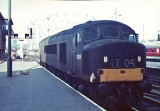
British Rail Class 45
Overview
British Rail
British Railways , which from 1965 traded as British Rail, was the operator of most of the rail transport in Great Britain between 1948 and 1997. It was formed from the nationalisation of the "Big Four" British railway companies and lasted until the gradual privatisation of British Rail, in stages...
Class 45 also known as the Sulzer Type 4 diesel locomotive
Diesel locomotive
A diesel locomotive is a type of railroad locomotive in which the prime mover is a diesel engine, a reciprocating engine operating on the Diesel cycle as invented by Dr. Rudolf Diesel...
s were built by British Rail at their Derby
Derby Works
The Midland Railway Locomotive Works, known locally as "the loco" comprised a number of British manufacturing facilities in Derby building locomotives and, initially, rolling stock in Derby, UK.-Early days:...
and Crewe Works
Crewe Works
Crewe railway works is a British railway engineering facility built in 1840 by the Grand Junction Railway. It is located in the town of Crewe, in the county of Cheshire....
between 1960 and 1962. Along with the similar Class 44
British Rail Class 44
The British Rail Class 44 or Sulzer Type 4 diesel locomotives were built by British Railways' Derby Works between 1959 to 1960. They were named after British mountains, and consequently nicknamed Peaks.-Description:...
and 46
British Rail Class 46
The British Rail Class 46 is a class of diesel locomotive. They were built from 1961-1963 at British Railways' Derby Works and were initially numbered D138-D193. With the arrival of TOPS they were renumbered to Class 46. Fifty-six locomotives were built...
locomotives they became known as "Peaks".
The Class 45s became the main traction on the Midland mainline from 1962 and their introduction allowed considerable acceleration of the previous steam powered service. The Class 45s remained the main source of power on the Midland mainline up to 1982 when they were relegated to secondary services following introduction of HSTs on the route.

